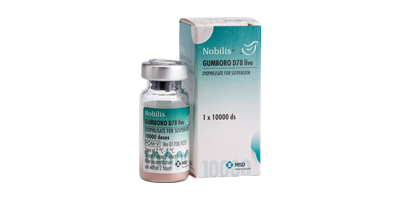| Directions for Use |
- Spray method
- Open the freeze-dried vaccine under water.
- The vaccine should be dissolved in cool, clean, non-chlorinated water which is free from iron.
- Stir or shake the vaccine solution and administer the vaccine.
- The spray apparatus should be free from sediments, corrosion and traces of disinfectants (to be used for vaccination purposes only).
- The vaccine-medicated water should be spread evenly over the correct number of chickens, at a distance of 30 to 40 cm, preferably when chickens are sitting together in dim light.
- The vaccine should be dissolved in water in a quantity of 1 000 doses/l of water.
- Intranasal/Eye Drop Instillation
- Open the vial and dissolve the vaccine in Intervet Diluent Oculo/Nasal.
- Administer the vaccine by means of a standardised dropper (usually 30 ml/1 000 doses).
- One drop should be applied from a height of a few centimetres onto 1 nostril or 1 eye.
- As an eye drop application, the drop should be allowed to spread evenly across the surface of the eye.
- Do not release the chicken until a swallowing motion is noticed.
- For numbers of chickens between standard dosages, the next higher dosage should be chosen.
- Drinking water
- Open the freeze-dried vaccine under water.
- The vaccine should be dissolved in cool, clean, non-chlorinated water which is free from iron.
- Stir or shake the vaccine solution and administer the vaccine.
- Ensure the uptake of all vaccine-medicated water in 2 hours.
- Ensure that the chickens are thirsty by withholding normal water supply from the chickens for 1 to 2 hours, depending on the ambient temperature.
- Ensure that there are enough drinkers available to ensure that all chickens have access to the vaccine-medicated water within 1 to 2 hours.
- Ensure that the water troughs are thoroughly cleaned prior to use.
- These should be clean and free from traces of detergents and disinfectants.
- The quantity of water to be used depends on a large number of factors including ambient temperature, stocking densities, etc.
- It is advisable to consult water consumption tables. An example of dosing rates is as follows:
- An example of dosing rates: Dissolve 1 000 doses in as many litres of water as the age of the chickens in days, to a maximum of 40 litres.
- The vaccine should be given in the early morning as this is the main drinking period, as well as the cooler period of the day.
- When vaccinating large flocks, it is advisable to start by dissolving only part of the vaccine.
- If the vaccine is administered through a central water supply or proportioner, greater care should be taken.
- For numbers of chickens between standard dosages, the next higher dosage should be chosen.
|
